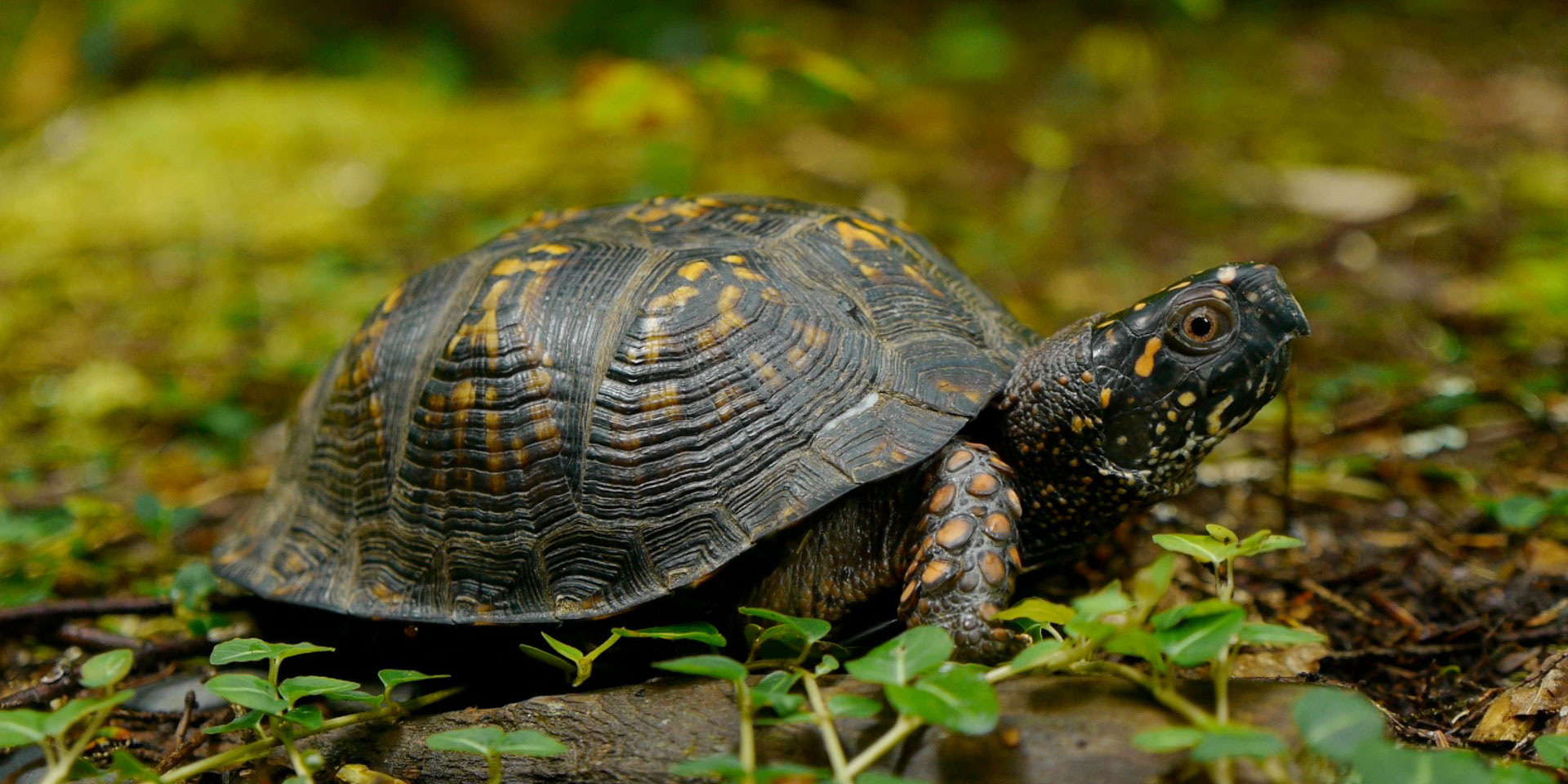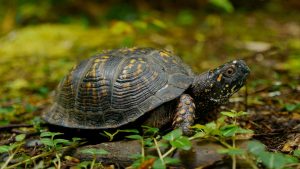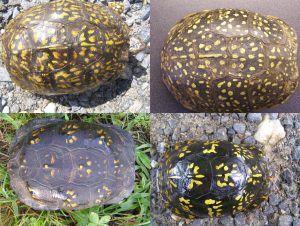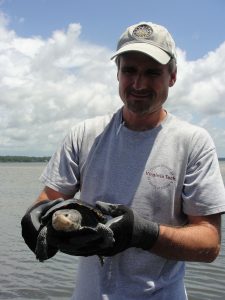

My neighbor has a special affinity for turtles. For years, whenever he saw a box turtle on the highway or crossing a secondary road, he would not just move it off the pavement, he would put it into his truck, take it home to his large, old farm property in East Tennessee, and there release it into a safe, new habitat far from all but a few winding country roads.
After many years of bringing home turtles, he noticed he was seeing more and more of them when out working in the woods and fields. He wondered if he had created a little population of them on his land. He also wondered, though, whether it could be somehow detrimental to the turtles to move them. I decided to investigate their natural history to see what could be learned.
The eastern box turtle is the most terrestrial species of turtle in Appalachia. When I was growing up in eastern Kentucky, we used to call them “terrapins.” But that term actually applies to aquatic species and now refers mostly to one called the diamondback terrapin found in marshy areas along the coast.

The box turtle is distinguished by having a hinge that allows it to close both plates of the lower shell against the upper shell. This completely encases the turtle’s fleshy body in a tightly sealed “box.”
According to Reptiles and Amphibians of the Smokies (Great Smoky Mountains Association, 2001), “Eastern box turtles spend the warm months wandering the woodlands and are especially active after rains. During dry periods they often bury themselves in mucky areas, with only the tops of their shells exposed. The approximate dates of hibernation are from the first frost in the fall until the last frost in the spring.”
Paul E. Super confirmed that they “do not burrow very deep down into the soil when they hibernate.” As the science coordinator for Great Smoky Mountains National Park, he has used little transmitters to monitor the movements of the turtles seen at The Purchase near Waynesville, North Carolina.
“They can be differentiated as individuals by the color patterns on their shells,” says Super.
“I’ve identified 38 individuals thus far up here at The Purchase, one of whom I’ve been identifying almost yearly for 14 years.” He hasn’t seen “Lucy” since 2020 but says he’s mostly been at his desk rather than hiking around in her territory.
One scientific paper Super shared with me states that “relocating box turtles . . . could endanger the relocated turtle. Box turtles . . . should be released as close as possible to the location where they were found to minimize mortality. However, if relocation is the only management option available, penning turtles for a time after they are relocated may help them establish a new home range” (Tuberville et al., 2005, cited in “Effects of Relocation on Movements and Home Ranges of Eastern Box Turtles” by Hester, Price, and Dorcas).

Safe Passage: The I-40 Pigeon River Gorge Wildlife Crossing Project is making recommendations to departments of transportation in both Western North Carolina and East Tennessee that can help many species near the Smokies have a better chance to get to the other side of the busy highway between Asheville and Knoxville. Steve Goodman is a conservation biologist with National Parks Conservation Association researching wildlife movement and mortality in the Pigeon River Gorge and along I-26 northwest of Asheville. He told me more about how relocation can affect turtles.
“Turtles have low egg and hatchling survival rates, and adults do not become sexually mature until 5 to 10 years old,” he explains. “Once mature, and after their shells are fully ossified, their survival rate can increase to 95 percent or higher. So, stable local populations are highly dependent on high annual adult survival rates. Removing adults from local populations—particularly considering their longevity of 50 to 100 years—can result in decades of lost reproductive potential and, depending on population size (most US populations seem to be declining), removing even just a few animals can be significantly detrimental to a local population’s viability.”

Some studies have indicated that box turtles possess a keen homing ability that compels most individuals to attempt to return to their home area. There are always exceptions, but most box turtles immediately take off from their relocation site in the general direction of their home territory, encountering increased threats from predators, roads, and weather extremes in unfamiliar habitats. Goodman says studies have shown the accuracy of their homing abilities diminishes after a few miles, but they may continue to expend substantial time and energy in their futile search.
“Turtles traveling across roads may be doing so as part of their normal foraging, breeding, and wintering cycles within their typical home ranges but could also be transients or long-dispersers that can travel distances of several miles or more,” says Goodman. “These long-distance travelers are thought to be important for genetic exchange across the larger landscape or for establishing new populations.”
According to Kenneth C. Dodd’s North American Box Turtles: A Natural History (Vol. 6. University of Oklahoma Press, 2002), relocating box turtles can have unintentional negative consequences at the new location such as disease transmission to resident turtles, or if no turtles currently exist there, reduction in fitness and survival due to small numbers of relocated individuals.
Goodman, who derived some of his information from Dodd’s book, says the bottom line is that even well-intentioned relocation of a turtle can contribute to its demise and does not necessarily equate to a sustainable conservation strategy. However, given the encroachment of development and roads on all habitats, the severity of threat does factor into the best course of action.

When you see a turtle crossing a road, it is generally recommended to move him or her across the road in the same direction of their travel—if you can do so safely, without putting your own life at risk. If the other side of the road has no suitable habitat (i.e., a new housing development or parking lot), then the next best option might be to relocate the turtle farther down the road as soon as suitable habitat picks up again. Goodman says box turtles do have the ability to breed and persist even in urban areas, and in these situations, humans helping with education, laws, and wildlife crossing opportunities does contribute to overall species conservation.
“The best actions we can take for box turtles in rural and even urban communities is to stress the importance of allowing them to freely move about, observing them from a distance, and facilitating their movements across dangerous roads when possible,” Goodman says. “Also, we can support efforts such as Safe Passage and land conservancies that are working to increase protection of roadside habitats, reduce fragmentation, and improve permeability across our highways.”
The Great Smokies Welcome Center is located on U.S. 321 in Townsend, TN, 2 miles from the west entrance to Great Smoky Mountains National Park. Visitors can get information about things to see and do in and around the national park and shop from a wide selection of books, gifts, and other Smokies merchandise. Daily, weekly, and annual parking tags for the national park are also available.